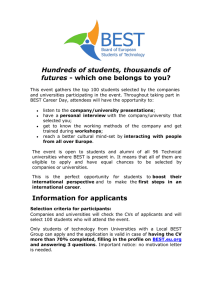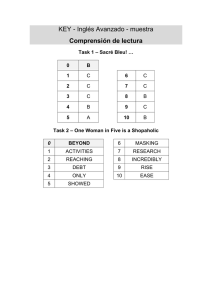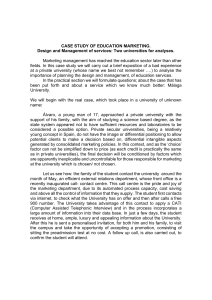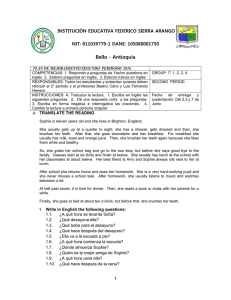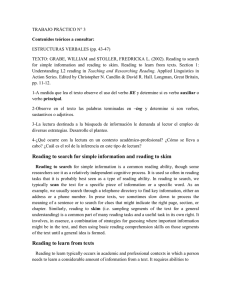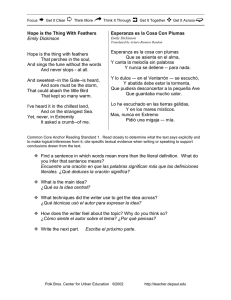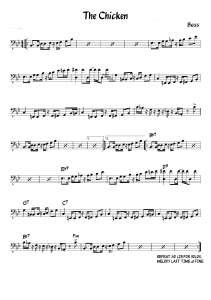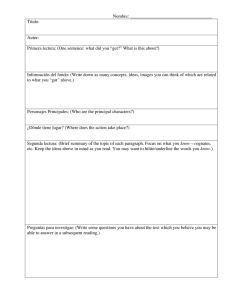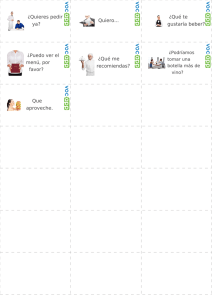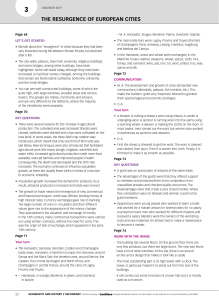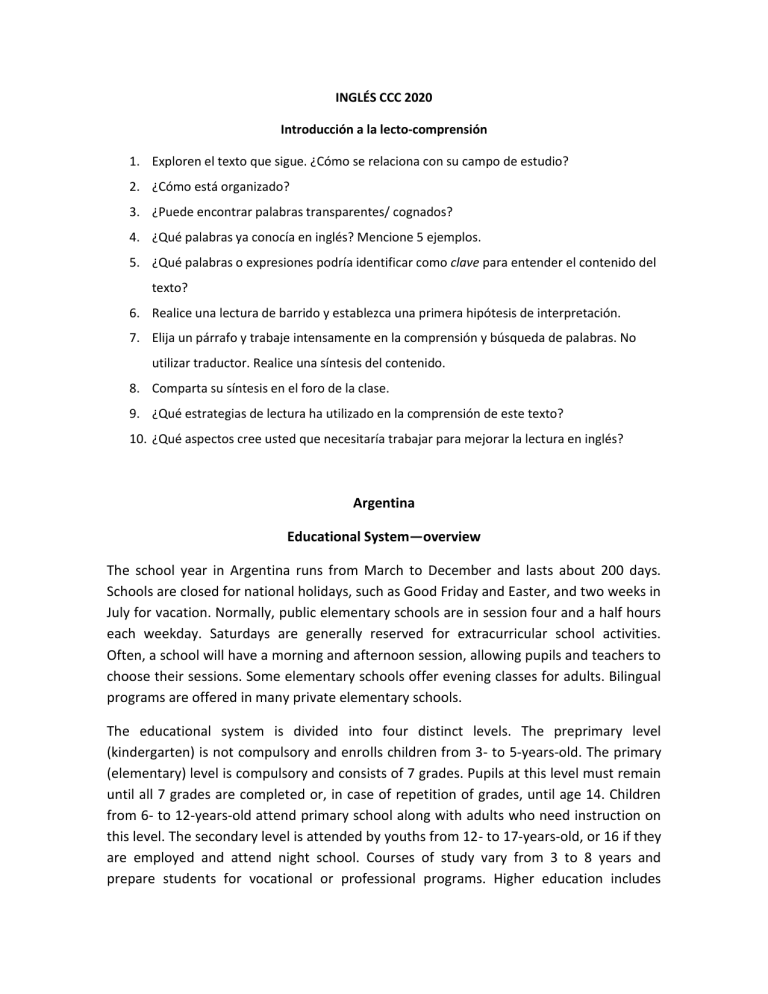
INGLÉS CCC 2020 Introducción a la lecto-comprensión 1. Exploren el texto que sigue. ¿Cómo se relaciona con su campo de estudio? 2. ¿Cómo está organizado? 3. ¿Puede encontrar palabras transparentes/ cognados? 4. ¿Qué palabras ya conocía en inglés? Mencione 5 ejemplos. 5. ¿Qué palabras o expresiones podría identificar como clave para entender el contenido del texto? 6. Realice una lectura de barrido y establezca una primera hipótesis de interpretación. 7. Elija un párrafo y trabaje intensamente en la comprensión y búsqueda de palabras. No utilizar traductor. Realice una síntesis del contenido. 8. Comparta su síntesis en el foro de la clase. 9. ¿Qué estrategias de lectura ha utilizado en la comprensión de este texto? 10. ¿Qué aspectos cree usted que necesitaría trabajar para mejorar la lectura en inglés? Argentina Educational System—overview The school year in Argentina runs from March to December and lasts about 200 days. Schools are closed for national holidays, such as Good Friday and Easter, and two weeks in July for vacation. Normally, public elementary schools are in session four and a half hours each weekday. Saturdays are generally reserved for extracurricular school activities. Often, a school will have a morning and afternoon session, allowing pupils and teachers to choose their sessions. Some elementary schools offer evening classes for adults. Bilingual programs are offered in many private elementary schools. The educational system is divided into four distinct levels. The preprimary level (kindergarten) is not compulsory and enrolls children from 3- to 5-years-old. The primary (elementary) level is compulsory and consists of 7 grades. Pupils at this level must remain until all 7 grades are completed or, in case of repetition of grades, until age 14. Children from 6- to 12-years-old attend primary school along with adults who need instruction on this level. The secondary level is attended by youths from 12- to 17-years-old, or 16 if they are employed and attend night school. Courses of study vary from 3 to 8 years and prepare students for vocational or professional programs. Higher education includes private and national universities and institutions that provide teacher training and advanced training in technical careers. University education is provided by public universities, either national or provincial, and by private universities. Since 1955, university entrance has been open to all students who have completed secondary school. Some public universities, such as the University of Buenos Aires, require an orientation course or an entrance exam, or both, and many private universities require other qualifications. The traditional university degree is awarded after five or six years of full-time study in a specialized field. Degrees may be obtained for completion of part of a program or for completion of a training program that enables the degree-holder to work in a specific profession. The academic year normally consists of two, four-month terms, and full-time students usually take three classes per term for six hours each week. Lecturing remains the principal method of instruction. The academic year begins in March and ends in December, although the calendar may vary somewhat from one department to another within the university. The typical university consists of independent schools or colleges in a particular field, such as law or agriculture, and these faculties are free to vary their grading system, calendar, and academic procedures. Universities design their own curricula and degree programs, but the National Authority for University Affairs approves them. Universities communicate with one another by way of the National Interuniversity Council, one for public and another for private universities, both composed of university rectors (presidents). Student unions also influence university policy, but neither the rectors' committees nor the student unions have any official authority over policy. Universities may award various kinds of degrees. The short-degree program, which takes two or three years to complete, trains a student for a specific area in the workforce, such as computer programming or librarianship. The intermediate degree takes three years and qualifies one for immediate employment in a specific profession or to continue for another two years and earn a license in a particular field. As with other degree programs, each university determines the length of the program and its curriculum. The medical degree ranges from five to seven years. Some universities require seven years of study for the same degree that others award in five years. Although most universities require students to take their courses in a prescribed sequence, those who earn a degree are qualified to practice in their field of study, such as law, medicine, or engineering. Wide diversity may be found in grading systems and examinations, dealing with failure, and many other aspects of university affairs. Since the 1980s, graduate degree programs have proliferated and include master's degrees along with doctoral degrees. Emphasis remains on training for a specific profession rather than on original research, and only about 7 percent pursue a postgraduate education, since a degree qualifies one to work in a profession without it. Increasingly, however, universities are requiring that all candidates for full professor hold an earned doctorate, and many of the professions are giving added importance to graduate degrees. The National Authority for University Affairs approves the degree, but no central authority on the national level oversees graduate programs, so standards vary considerably among the universities. Doctoral programs usually include course work and a thesis that contributes new knowledge to a field of study. A great discrepancy between urban and rural schools remains. Many of the provinces are geographically isolated, and nearly 50 percent of the country's population lives in metropolitan Buenos Aires, leaving the rural areas with very little power to dictate policy at the national level. Consequently, educational attainment is lower in the rural areas. On the whole, however, many improvements have been made since the return of democratic government in 1983. Rural education has been expanded, more than 17,000 adult schools have been built, and hundreds of secondary schools offer night classes to those in the workforce. Source: https://education.stateuniversity.com/pages/56/Argentina-EDUCATIONAL-SYSTEMOVERVIEW.html
